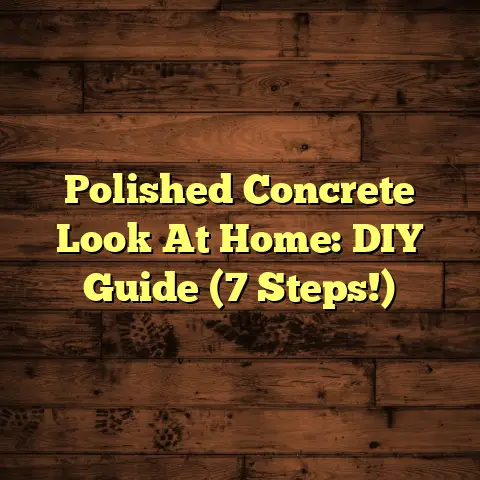Best Wash for Wood Floors? (4 Pro Secrets!)
Ever walk into a home and feel instantly welcomed? Chances are, the wood floors had something to do with it.
I’ve spent years as a flooring contractor, and I can tell you, nothing beats the warmth and character of beautifully maintained wood.
Think about it: those floors have seen it all – birthday parties, cozy nights in, maybe even a spilled glass of wine or two (we’ve all been there!).
Keeping them clean isn’t just about appearances; it’s about preserving those memories and the heart of your home.
So, how do you keep your wood floors looking their best?
Let’s dive into the secrets I’ve learned over the years.
Section 1: Understanding Wood Floors
and Their Needs
The Beauty of Wood Floors
Wood floors bring a unique warmth and elegance that’s hard to replicate.
I’ve worked with countless types, from classic hardwood like oak and maple, to the more budget-friendly engineered wood, and even laminate options.
-
Hardwood: Solid wood all the way through, offering timeless beauty and the ability to be refinished multiple times.
-
Engineered Wood: Layers of wood bonded together, making it more stable in humid environments than solid hardwood.
-
Laminate: A synthetic material designed to mimic the look of wood. It’s durable and affordable, but can’t be refinished.
Each type has its own unique characteristics and, importantly, its own specific care requirements.
Importance of Cleaning
Why is cleaning so important?
Well, it’s not just about making your floors shine. Dirt, dust, and grime act like sandpaper on your floor’s finish.
Over time, they can scratch and dull the surface, leading to costly repairs or even replacement.
Think of all the foot traffic your floors endure. Pets, kids, guests – they all bring in dirt and debris.
Regular cleaning removes these abrasive particles, protecting the finish and extending the life of your floors.
A study by the National Wood Flooring Association (NWFA) found that proper maintenance, including regular cleaning, can significantly increase the lifespan of a wood floor. (Source: NWFA Technical Manual)
Section 2: The Essential Components
of a Good Wood Floor Wash
pH Balance Matters
This is where things get a little technical, but trust me, it’s crucial.
The pH level of your cleaner can make or break your floor’s finish.
Harsh chemicals, like those found in some all-purpose cleaners, can strip away the protective coating, leaving the wood vulnerable to damage.
Ideally, you want a pH-balanced cleaner specifically designed for wood floors.
These cleaners are formulated to gently remove dirt and grime without harming the finish.
Avoid cleaners that contain ammonia, bleach, or vinegar, as these can be too harsh.
Natural vs. Commercial Products
Ah, the age-old debate!
I’ve seen homeowners swear by both natural and commercial cleaning solutions.
-
Natural Solutions: Often involve ingredients like vinegar, baking soda, and essential oils. They’re generally considered safer for your family and the environment.
-
Commercial Products: Formulated specifically for wood floors, often containing ingredients that enhance shine and protect the finish.
The key is to do your research and choose a product that aligns with your values and your floor’s specific needs.
Some popular commercial options include Bona Hardwood Floor Cleaner and Murphy Oil Soap (although use Murphy Oil Soap sparingly as it can leave a residue over time).
For natural options, a simple solution of water and a few drops of mild dish soap can often do the trick.
Section 3: 4 Pro Secrets to Choosing
the Best Wash for Your Wood Floors
Alright, let’s get to the good stuff!
These are the secrets I share with my clients to keep their wood floors looking fantastic.
Secret #1: Test Before You Clean
This is my golden rule.
Before you use any new cleaning product on your entire floor, do a patch test in a small, inconspicuous area.
I usually recommend testing in a closet or under a piece of furniture.
Apply the cleaner according to the instructions and let it dry completely.
Check for any discoloration, cloudiness, or other adverse reactions.
If everything looks good, you’re safe to proceed. If not, find another cleaner!
Secret #2: The Right Technique Matters
How you apply the cleaner is just as important as what you use.
I always recommend using a microfiber mop.
These mops are gentle on the finish and effectively pick up dirt and grime.
Avoid using traditional string mops, as they can leave behind too much water.
The key is to use a damp, not wet, mop.
Wring out the mop thoroughly before applying it to the floor.
You want to clean the surface, not soak it.
Mop in the direction of the wood grain to avoid streaks.
After mopping, you can use a clean, dry cloth to buff the floor and remove any remaining moisture.
Secret #3: Frequency of Cleaning
How often should you wash your wood floors?
It depends on your lifestyle.
If you have pets or kids, or if you live in a high-traffic area, you’ll need to clean more often.
As a general rule, I recommend sweeping or vacuuming your wood floors at least once a week.
This removes loose dirt and debris before they can scratch the finish.
Washing your floors every 1-2 months is usually sufficient for most households.
However, if you notice your floors looking dull or dirty, don’t hesitate to wash them more often.
Just be careful not to over-clean, as this can wear down the finish over time.
Secret #4: Seasonal Considerations
Did you know that the seasons can affect your wood floor maintenance routine?
In the winter, when the air is dry, wood floors can shrink and develop gaps.
During this time, it’s important to avoid over-cleaning, as this can further dry out the wood.
You may also want to consider using a humidifier to maintain a healthy moisture level in your home.
In the summer, when the air is humid, wood floors can expand.
During this time, it’s important to clean up spills quickly to prevent water damage.
You may also want to increase your cleaning frequency to remove any excess moisture.
Section 4: Common Mistakes to Avoid
When Washing Wood Floors
Let’s talk about some common pitfalls I’ve seen homeowners fall into.
Avoiding these mistakes will save you time, money, and headaches in the long run.
-
Using Too Much Water: This is a big one. Excess water can seep into the seams of your floors and cause warping, cupping, or even mold growth. Always use a damp, not wet, mop.
-
Neglecting to Sweep or Vacuum First: Washing a dirty floor is like washing your car without rinsing off the mud first. You’re just spreading the dirt around. Always sweep or vacuum thoroughly before washing.
-
Using the Wrong Type of Cleaner: As we discussed earlier, harsh chemicals can damage your floor’s finish. Always use a pH-balanced cleaner specifically designed for wood floors.
-
Using Abrasive Cleaning Tools: Steel wool, scouring pads, and other abrasive tools can scratch your floor’s finish. Stick to microfiber mops and soft cloths.
-
Not Drying the Floor Properly: Leaving water to sit on your floor can lead to water damage. After mopping, use a clean, dry cloth to buff the floor and remove any remaining moisture.
Section 5: DIY Wood Floor Wash Recipes
Want to save some money and use ingredients you already have at home?
Here are a few DIY recipes I’ve found to be effective:
-
Simple Water and Dish Soap Solution: Mix a few drops of mild dish soap with warm water. This is a gentle and effective way to clean most wood floors. Be sure to use a pH-neutral dish soap.
-
Vinegar and Water Solution: Mix 1/2 cup of white vinegar with 1 gallon of warm water. Vinegar is a natural disinfectant and can help to remove stubborn stains. However, use this solution sparingly, as too much vinegar can dull the finish over time.
-
Essential Oil Blend: Add a few drops of your favorite essential oil to any of the above solutions. Essential oils can add a pleasant scent and have antimicrobial properties. Lavender, lemon, and tea tree oil are all good options.
Important Note: Always test any DIY solution in a small, inconspicuous area before using it on your entire floor.
Conclusion
Your wood floors are more than just a surface you walk on.
They’re a reflection of your home, your style, and your memories.
By taking the time to properly care for them, you can ensure that they continue to bring warmth and beauty to your home for years to come.
I hope these pro secrets have been helpful.
Remember, a little effort goes a long way in preserving the beauty and integrity of your wood floors.
Call to Action
Now, I’d love to hear from you!
What are your favorite tips and tricks for washing wood floors?
Share your experiences in the comments below or on social media using #WoodFloorCare.
Let’s create a community of shared knowledge and passion for home care!





